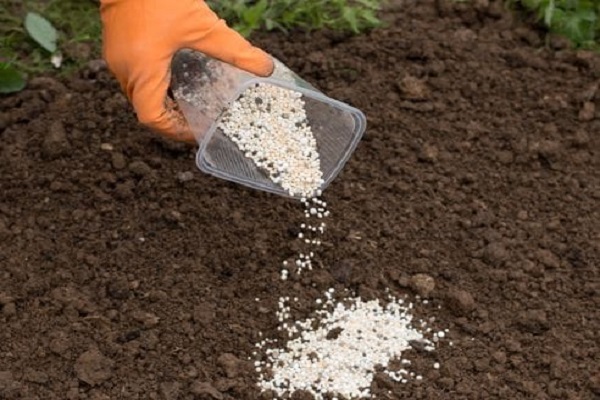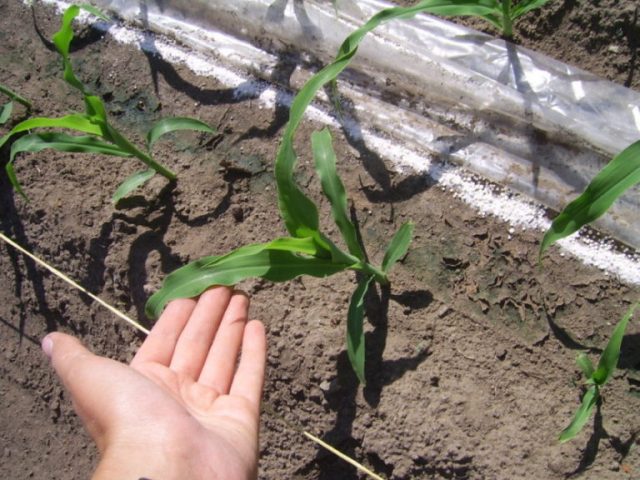Content
Top dressing of corn and yield are interrelated. Competent introduction of nutrients ensures intensive crop growth and fruiting. The degree of assimilation of microelements depends on the structure, temperature, soil moisture, and its pH.
What nutrients does corn need?
At different stages of development, the needs of corn for nutrients change. This must be taken into account when drawing up a feeding scheme. The active intake of nitrogen (N) in maize starts at the 6-8 leaf phase.
Before their appearance, the plant assimilates only 3% nitrogen, from the appearance of 8 leaves to drying out on the cobs of hair - 85%, the remaining 10-12% - in the ripening phase. The yield of corn and the volume of biomass depend on nitrogen.
Potassium (K) also affects yield:
- improves the consumption and use of moisture;
- potassium dressing contributes to good graining of the ears;
- increases drought resistance of corn.
Corn has the greatest need for potassium in the flowering phase. The culture needs less phosphorus (P) than nitrogen and potassium. This can be assessed in terms of the digestibility of nutrients. With a productivity of 80 kg / ha, the ratio N: P: K is 1: 0.34: 1.2.
Nutrient P (phosphorus) is needed in corn in 2 phases:
- at the initial stage of growth;
- during the period when the generative organs are formed.
It participates in the formation of the root system, has a direct effect on energy metabolism, promotes the accumulation and synthesis of carbohydrates, participates in the processes of photosynthesis and respiration.
For the full assimilation of the NPK complex, corn needs calcium. With its lack, soil parameters deteriorate (physical, physicochemical, biological):
- there is an increase in specific gravity;
- the structure changes for the worse;
- buffering deteriorates;
- the level of mineral nutrition decreases.
The lack of magnesium (Mg) in the soil is manifested by low productivity, its deficiency affects the processes of flowering, pollination, grain size and quantity of ears.
Sulfur (S) affects the strength of growth and the degree of nitrogen absorption. Its deficiency is manifested by a change in the color of the leaves. They turn light green or yellow. With this in mind, it is necessary to feed corn growing in the country or in the field. At the same time, it is necessary to remember about the role of trace elements on the enzymatic system of corn.
The culture during the growing season needs zinc, boron, copper:
- copper increases the percentage of sugar and protein in grains, affects productivity and immunity;
- with a lack of boron, growth slows down, flowering, pollination worsens, internodes are reduced in the stems, the cobs are deformed;
- zinc for corn is in the first place, it participates in metabolic processes, the strength of growth and frost resistance depend on it, with its deficiency, ears may be absent.
Fertilizer types and application rates
The minimum amount of fertilizer for corn is calculated on the basis of the expected yield. The calculation is based on the needs of the culture in the basic nutrients.
Battery | The rate for obtaining 1 t / ha |
N | 24-32 kg |
K | 25-35 kg |
P | 10-14 kg |
Mg | 6 Kg |
Ca | 6 Kg |
B | 11 g |
Cu | 14 g |
S | 3 Kg |
Mn | 110 g |
Zn | 85 g |
Mo | 0.9 g |
Fe | 200 g |
The norms are given for a plot of 100 x 100 m, if corn is grown on an area of 1 hundred square meters (10 x 10 m), all values are divided by 10.
Organic
In the open field in the country, in the field, liquid manure is traditionally used for feeding corn. Root infusion recipe:
- water - 50 l;
- fresh mullein - 10 kg;
- insist 5 days.
When watering, for every 10 liters of irrigation water, add 2 liters of liquid manure.
Mineral
All mineral fertilizers, according to the presence of nutrients in them, are divided into simple, containing one nutritional element, and complex (multicomponent).
For feeding corn, simple forms of mineral fertilizers are used:
- nitrogen;
- phosphoric;
- potash.
Potash and phosphoric
Highly concentrated forms of fertilizers are chosen for feeding corn. Of the phosphorus preparations, preference is given to:
- superphosphate;
- double superphosphate;
- phosphoric flour;
- ammophos.
With a yield of 1 t / ha, the rate of potash fertilizers is 25-30 kg / ha. Potassium salt, potassium chloride (in autumn) are applied under the corn.
Nitrogen
Fertilizers can contain nitrogen in amide (NH2), ammonium (NH4), nitrate (NO3) forms. The root system of corn assimilates the nitrate form - it is mobile, easily assimilated at low soil temperatures. The plant assimilates the amide form of nitrogen through the leaves. The transition of nitrogen from the amide form to the nitrate form takes from 1 to 4 days, from NH4 to NO3 - from 7 to 40 days.
Name | Nitrogen form | Temperature regime when applied to the soil | Features of the |
Urea | Amide | +5 to +10 ° C | Autumn application is ineffective, the nitrogen is washed out by melt water |
Ammonium nitrate | Ammonium | Not more than +10 ° C | Wet soil |
Nitrate | |||
UAN (urea-ammonia mixture) | Amide | Does not affect | The soil can be dry, moist |
Ammonium | |||
Nitrate |
Top dressing of corn with urea per leaf
The rate of nitrogen assimilation increases by the time 6-8 leaves appear. This falls on the second half of June. The need for nitrogen does not decrease until it dries on the cobs of hair. Foliar top dressing with urea solution is carried out in 2 stages:
- in the phase of 5-8 leaves;
- during the formation of the cobs.
In industrial fields, the nitrogen norm is 30-60 kg / ha. When growing corn on a small scale, use a 4% solution:
- water - 100 l;
- urea - 4 kg.
In ripe corn grains, the protein content rises to 22% with foliar feeding with urea. To treat 1 hectare, 250 liters of a 4% solution are required.
Top dressing of corn with ammonium nitrate
Foliar dressing with ammonium nitrate is carried out when symptoms of nitrogen starvation appear. The deficiency is manifested by thin stems, a change in the color of the leaf plates. They turn yellow-green. Rate for corn:
- water - 10 l;
- ammonium nitrate - 500 g.
Terms and methods of feeding
The culture needs nutrients throughout the growing season. Applying the entire fertilizer rate at one time is not beneficial. Changes in the feeding scheme affect the yield and the quality of the ears.
In the traditional food system, there are 3 periods for the introduction of mineral fertilizers:
- the main part is applied before the beginning of the sowing period;
- the second part is applied during the sowing period;
- the remainder of the mineral nutrition is added after the sowing period.
Fertilizers before sowing corn
Organic matter (manure) and the required amount of phosphorus-potassium fertilizers are sealed in clay soils in the fall (during autumn processing). Manure is applied to sandy and sandy loam soils in the spring. During spring cultivation, nitrogen is replenished, ammonium nitrate, ammonium sulfate, and ammonia water are used.
Ammonium sulfate contains sulfur, which is necessary for the synthesis of proteins, as well as ammonium (NH4). It is used as the main fertilizer for pre-sowing spring feeding of corn. The recommended fertilization rate is 100-120 kg / ha.
Fertilizers when planting grains
When sowing, fertilizers containing phosphorus and potassium are applied.Of the phosphorus fertilizers, preference is given to superphosphate and ammophos. They are applied at the rate of 10 kg / ha. The action of ammophos appears faster. It contains: phosphorus - 52%, ammonia - 12%.
The granules are applied to a depth of 3 cm. Exceeding the recommended norms leads to a decrease in yield. Ammonium nitrate is considered the best nitrogen supplement. It is introduced into the soil when sowing corn. The recommended application rate is 7-10 kg / ha.
Top dressing of corn after the leaves appear
When the crop is in the 3-7 leaf phase, fertilizers are embedded in the soil. Organics are initially introduced:
- slurry manure - 3 t / ha;
- chicken droppings - 4 t / ha.
The second feeding is carried out with superphosphate (1 c / ha) and potassium salt (700 kg / ha). Within 3 weeks from the appearance of 7 leaves, root top dressing with urea is carried out. Corn is sprayed in calm weather, the optimum air temperature is 10-20 ° C.
In the industrial cultivation of corn, fertilizing with UAN is practiced - a carbamide-ammonia mixture. This fertilizer is used twice during the growing season:
- before the appearance of the 4th leaf;
- before closing the leaves.
Corn plantings are watered with a liquid UAN solution in the amount of 89-162 l / ha.
In the early stages of growth, maize may show symptoms of zinc deficiency:
- stunting;
- yellowish color of young leaves;
- white and yellow stripes;
- short internodes;
- shrunken lower leaves.
Zinc deficiency affects carbohydrate metabolism, affects the quality of the ears.
When symptoms of starvation appear, foliar feeding is carried out. Zinc fertilizers are used:
- NANIT Zn;
- ADOB Zn II IDHA;
- zinc sulfate.
During the drought period, corn is fed with potassium humate. This allows you to increase the yield by 3 c / ha. Under normal humidity conditions, this figure rises to 5-10 c / ha. Foliar dressing is carried out in the phase of 3-5th and 6-9th leaves.
Advantages and disadvantages of fertilizers
When choosing a fertilizer, you need to take into account its positive and negative effects on the soil, especially the application.
Fertilizer type | pros | Minuses |
Liquid manure | Increased yield | Crust on soil after watering |
Ammonium sulfate | Low cost, improves the quality of fruits, increases keeping quality, prevents the accumulation of nitrates | Acidifies the soil |
Urea | When feeding on a leaf, nitrogen is absorbed by 90% | Ineffective in cold weather |
Ammonium nitrate | It is convenient and fast to deposit | Increases soil acidity |
CAS | There is no nitrogen loss, the nitrate form contributes to the reproduction of beneficial soil microflora, which mineralizes organic residues, this is especially effective when growing corn using the technology | Very corrosive liquid, there are restrictions on transportation methods and storage conditions |
Superphosphate | Accelerates the ripening of the ears, increases cold resistance, has a positive effect on the quality composition of the silage | Cannot be mixed with fertilizers containing nitrogen (ammonium nitrate, chalk, urea) |
Conclusion
Competently organized feeding of corn is necessary throughout the warm season. It consists of basic and corrective actions. The choice of fertilizers, the rate of application, is determined by the climatic conditions of the region, the composition and structure of the soil.











